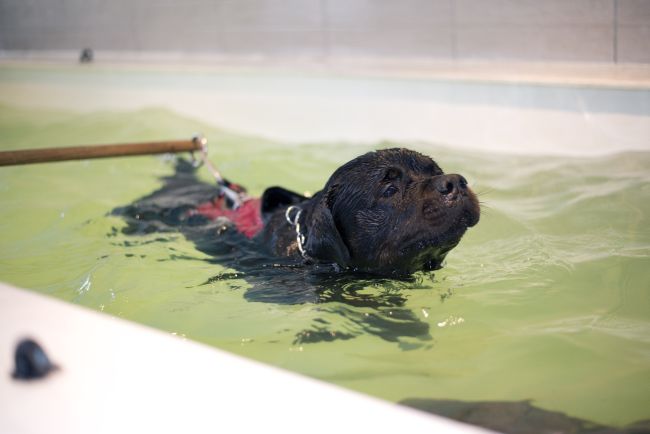 Often when people experience chronic pain, strain or injuries such as spinal restriction, joint pain, or a knee injury, they are often prescribed sessions of physical therapy. One of the more popular methods of treatment are aquatic therapies of some kind, since they remove tension and joint strain. In recent years, the same kinds of heated water treatments have also been found to greatly improve the quality of rehabilitation in canine injuries.
Often when people experience chronic pain, strain or injuries such as spinal restriction, joint pain, or a knee injury, they are often prescribed sessions of physical therapy. One of the more popular methods of treatment are aquatic therapies of some kind, since they remove tension and joint strain. In recent years, the same kinds of heated water treatments have also been found to greatly improve the quality of rehabilitation in canine injuries.
What is hydrotherapy?
Hydrotherapy is basically controlled swimming exercises that allow a dog to be immersed in warm water, balanced according to weight and height. The dog then begins swimming in the hydrotherapy pool, or walking on an aquatic treadmill, where he slowly begins rehabilitation and therapy of the muscles. Both methods of training are effective. By walking in warm water, the muscles are relaxed and soothed, and the water allows the body extra buoyancy, which removes additional strain to the weight-bearing joints. When a dog experiences hydrotherapy through swimming, he often wears a harness connected to a suspension, which acts as a support should the dog become fatigued at any time. The pools generally also have current jets which can increase in force, helping the do to swim more strongly.
Over-all Health Benefits of Hydrotherapy
As with most heated aquatic treatments, they are low-impact exercises that tone muscle and improve cardiovascular strength. Whether the dog is rigorously training for agility events, or if he has strained his right foreleg, hydrotherapy will provide the following benefits:
- Physique maintenance and muscle strengthening
- Cross-training for competing dogs ( such as racing breed, skill-training breeds, etc.)
- Pain & muscles spasm alleviation
- Cardiovascular training
- Improved blood circulation
- Strengthening of core muscles
- Gait balance improvement
- Better range of motion
- Reduced soreness, stiff joints and swelling
Conditions Which May Benefit From Hydrotherapy
While each dog’s condition may vary based on circumstances, hydrotherapy usually proves effective in speeding up the recovery process. For example, some vets prescribe hydrotherapy as a pre-surgical and post-surgical treatments to help the dog’s body prepare and adjust to the changes accordingly. Below are some of the most common canine conditions which might necessitate sessions of hydrotherapy.
- Dysplasia (of the hip and elbow)
- Patella Luxation
- Post-surgical treatments (such as hip replacement, patella luxation, arthroscopy, etc.)
- Degenerative Myelopathy (DM)
- Spinal diseases, injury or trauma
- Intervertebral Disc Protrusion/Degenerative Disc Disease
- Tendinitis
- Cranial Cruciate Rupture
- Spondylosis
- Ligament strain
- Cervical Vertebral Malformation
Obesity (This is a particularly helpful treatment for dogs who need exercise, without putting too much strain on their joints and incurring injuries.)

